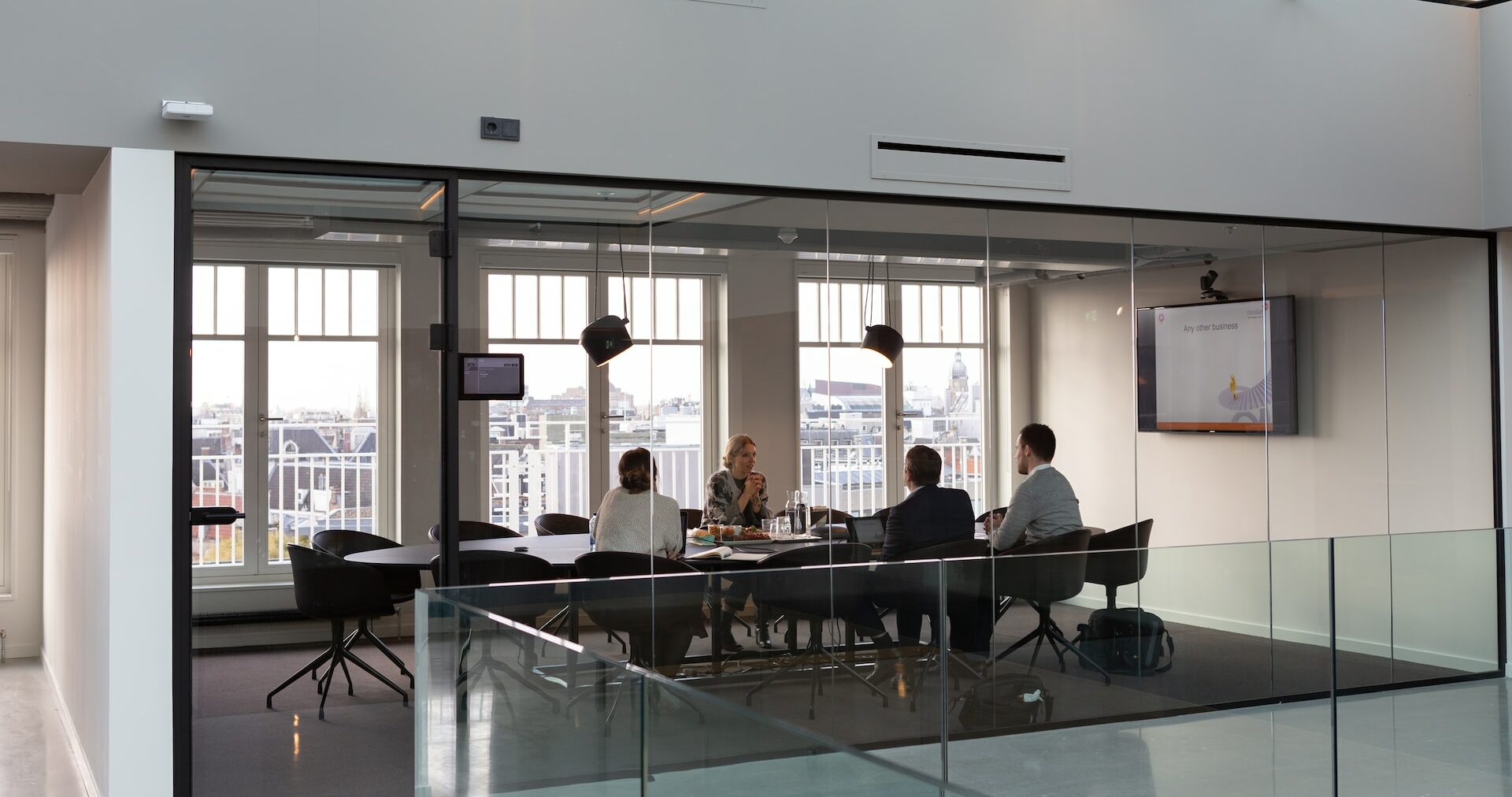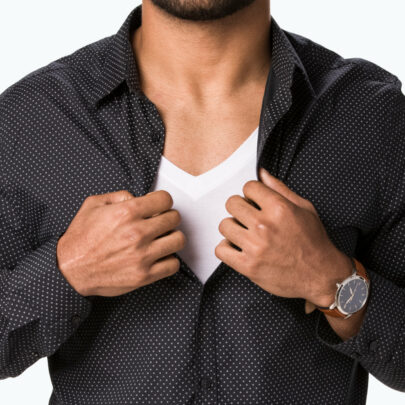Business Casual for Men: What It Means & What To Wear
You have a lot of freedom of choice as you put together your business casual wardrobe.
- Updated: February 7, 2023
- Published: January 20, 2023

Our approach to content is the same as our approach to building a great wardrobe: it's about quality, not quantity. We only recommend products we believe in and would buy for ourselves or a friend.
Here's our editorial promise:
- We only recommend products we believe in and would buy for ourselves or a friend.
- We don’t accept payment for reviews, ever. We do sometimes receive press samples.
- Every review is hands-on, meaning we actually test drive the products.
- We cover brands regardless of our relationship with them (i.e., brands that don’t offer payment for traffic).
Your trust is our #1 priority, always. Please reach out with any questions, concerns or suggestions ([email protected]).
in this article:
Rising in popularity as professional settings become less rigid, business casual is among the most relaxed dress codes you’ll ever come across. Requiring just a touch more refinement than ripped jeans and a t-shirt, you have a lot of freedom of choice as you put together your business casual wardrobe.
With freedom, however, comes ambiguity. In this guide, we’ll cover exactly what is acceptable and what isn’t when it comes to business casual, so you never look out of place.
What Does Business Casual Mean?
Although not a difficult dress code to meet, business casual is a nuanced dress code that requires careful consideration to avoid showing up underdressed or overdressed.
But what precisely does business casual for men entail? Put simply, a business casual dress code calls for a long-sleeve collared shirt, chinos, khakis, or dark-colored jeans, and a pair of leather shoes.
In more relaxed workplaces, business casual is the go-to everyday workwear or job interview attire. You’ll also find business casual outside of professional settings – nice lunch spots, golf clubs, and some daytime academic or sport events, like Model UN competitions and professional tennis matches, for example.
Business Casual vs. Smart Casual
Smart casual is the least formal dress code, while business casual is just a touch more formal. It’s another popular choice for business attire, as well as any event that requires a bit more sophistication, like brunches, or daytime events like engagement parties or wedding luncheons.
In both smart and business casual settings, you can skip the jacket. But wearing smart casual, you can untuck your shirt and even wear a pair of sneakers, too.
Style Guide: How Do You Style A Business Casual Outfit?
When dressing business casual, you have plenty of options. You have a lot of opportunity to inject more personality into what you wear, but on the flip side, there’s more room to mess up.
Here’s exactly what is acceptable in business casual settings:
Business Casual Attire: Jackets
You don’t need a jacket for business casual events, though you’re more than welcome to wear one. The following are acceptable jacket styles for a business casual look:
- Suit Jackets – suit jackets, when styled with khakis or dark jeans, can add a formal feel without feeling overdressed. To add to the casual feel, go for a tweed or cotton in a light blue or brown, or a smaller herringbone or plaid.
- Blazers – a bit more casual than a suit jacket, a knit, cotton, or even corduroy blazer is perfect to complete a business casual look, adding structure and elegance without dressing you up too much.
- Sport Coats – sports jackets can perfectly complete a business casual outfit while remaining relaxed looking. Feel free to experiment with patterns like plaid and windowpane here, as well as solid colors like blue or brown.
Business Casual Attire: Shirts
While a dress shirt may not always feel like the most casual option when it comes to a business casual dress code, the absence of a tie makes a shirt relatively informal.
- Dress Shirts – when choosing a dress shirt, it’s best to stick with a white or light blue. These colors are the most versatile, and can work for both formal and informal occasions.
- Oxford Shirts – oxford shirts are a more casual, button-down collared shirt, made of ‘oxford’ fabric, which is rougher and less shiny than dress shirt fabric. Oxford shirts perfectly tow the line between casual and formal, making them the perfect pick for business casual settings.
- Polo Shirts – although a polo shirt may not be suitable for all business casual environments, they do have their place – use your best judgment before wearing one. If you do decide to go for it, stick to solid, more formal colors like white or dark blue.
Business Casual Attire: Sweaters & Cardigans
Sweaters and cardigans bring a stylish, yet subtle charm to a business casual look. Go for premium materials like cashmere or merino wool, and aim for a slightly less-than figure-hugging fit for the most flattering look.
Business Casual Attire: Dress Pants
- Slacks – slacks are the dressiest pants you can wear in a business casual setting. To keep them relatively informal, pair them with a polo shirt and loafers.
- Khakis – khaki pants, complete with a dress shirt on top, can present a refined yet understated look. To dress these pants up, pair them with a leather belt and matching leather shoes, and to dress them down, unbutton 2 or 3 buttons on your dress shirt for a relaxed but still stylish vibe.
- Chinos – chinos are slightly lighter and more summery than khakis. Stick with black, gray, tan, or dark-toned colors paired with a blazer, white dress shirt, and loafers.
- Corduroys – corduroys have the rare ability to look both dressed up and casual at the same time, so when you don’t quite know what to wear, you can’t go wrong with these. Add a sports jacket, dress shirt, and some brogues or loafers to finish out the look.
- Dark-Wash Denim – dark-wash denim, never light-wash, are ok in most business casual settings. Pair jeans with a suit jacket, oxford shirt, belt, and matching brogues for a simple but elegant look.
Business Casual Attire: Dress Shoes
- Derbies – comfortable yet stylish, derbies are one of the most formal shoes you can wear. To stay casual, pair your derbies with a chunky knitted sweater for a laid-back look, or add a sports coat for a more traditional silhouette.
- Oxfords – similar to dockers, Oxfords are a great option when the dress code is still business casual, leaning into more formal. Their closed-lacing construction gives them a clean, sophisticated look. Wear these with a jacket for a more formal look, or opt for a dress shirt and dark-wash denim to stay casual.
- Loafers – less formal than Oxfords, loafers will work well in a variety of settings. Dress them up with dark denim jeans or chinos, or a simple t-shirt will make the look far less dramatic.
- Brogues – by far, one of the best options for business casual are half or full-brogues. While still dressy, they are less formal than Oxfords and work brilliantly well with just about any jacket or shirt.
- Monk Straps – a personal favorite, monk straps work great in both casual and more formal settings. Team these shoes with a crisp dress shirt or a polo shirt if you want to look less dressy.
- Chelsea Boots – a great fall or winter choice, Chelsea boots work with just about any outfit combination. Dress them up with dress pants and a blazer, or stay casual with dark denim and a sport coat.
What Is Not Business Casual Attire?
- Suits – there aren’t many ways to dress down a suit. So, it’s best to stay away from them for business casual environments, unless you don’t mind sticking out.
- Light Wash Jeans – light-wash denim might pass in smart casual settings, but are too informal for business casual.
- T-Shirts – maybe t-shirts could be styled well for business casual with a suit jacket and dress pants, but for the most part, t-shirts should always be left for your more casual events.
- Sneakers – a pair of clean sneakers, again, might pass in smart casual settings, but are not formal enough for business casual environments.
- Hoodies – hoodies will always make the wearer look lazy in their choice of clothes and never work in business casual settings.
Style Tips To Elevate Your Business Casual Look
Find A Good Tailor
Business casual wear should still look fitted and polished. Plus, well-tailored clothes can improve your overall look, fit, and confidence, allowing you to look and feel your very best in just about any setting.
Wear An Undershirt
It’s important to pair an undershirt with all types of menswear, not just in the office or at special occasions. A fitted, quality undershirt can help streamline the look of your body, regulate your temperature, and prevent sweat stains and odor.
An important note – avoid baggy undershirts, as they’ll do little for your shape and can actually make you look heavier than you are. Plus, they won’t do much to protect your clothes from odor and sweat stains.
Play With Personal Style
The relative informality of business casual gives men a lot more freedom for self-expression, as long as they play within the rules.
Consider adding pocket squares, lapel pins, or cufflinks to an outfit to put your own stamp on your look. Just remember that less is almost always more, so be careful not to overdo it.
Business Casual FAQs
Can I Wear Jeans For Business Casual?
Dark denim jeans are acceptable as part of a business casual look. However, it’s important to stay away from lighter denim as this can completely throw off the look, making you look sloppy at best and incompetent at worst.
Are T-Shirts Business Casual?
T-shirts aren’t considered business casual and should be avoided. Instead, consider Oxford shirts, dress shirts, or polo shirts to round out your look.
Can Sneakers Ever Be Business Casual?
While some people think sneakers can be business casual, in our opinion, sneakers are just a bit too informal and should not be considered a part of business casual attire.
Look Polished Even In Your Most Casual Wear
It isn’t always easy to interpret a dress code, but luckily, business casual is one of the most straightforward to maneuver. By sticking to the rules, as well as giving yourself a little room to incorporate your own personal style, you can create an outfit that makes you look sophisticated without overdoing it.
Don’t forget, whatever you decide to wear, be sure to invest in a high-quality undershirt to enhance your shape, protect your clothes, and increase your confidence. Check out our range of premium undershirts in crew neck and V-neck designs to find the best fit for you.
About Leigh McKenzie
Leigh is the owner of UnderFit, a premium men's undershirt brand based in Philadelphia, PA. You can follow Leigh on LinkedIn and Twitter.

Meet Your New Favorite Undershirts
-
Anti-Pilling
-
Incredibly Soft
-
Breathable
-
Moisture-Wicking
-
4-Way Stretch
-
Anti-Odor
Try UnderFit for 100 days. Experience mind-blowing softness or get your money back.
Welcome Back
Don’t have an account? Sign up
New Here?
Already have an account? Log in
Forgot your password?
We will send you an email to reset your password.


